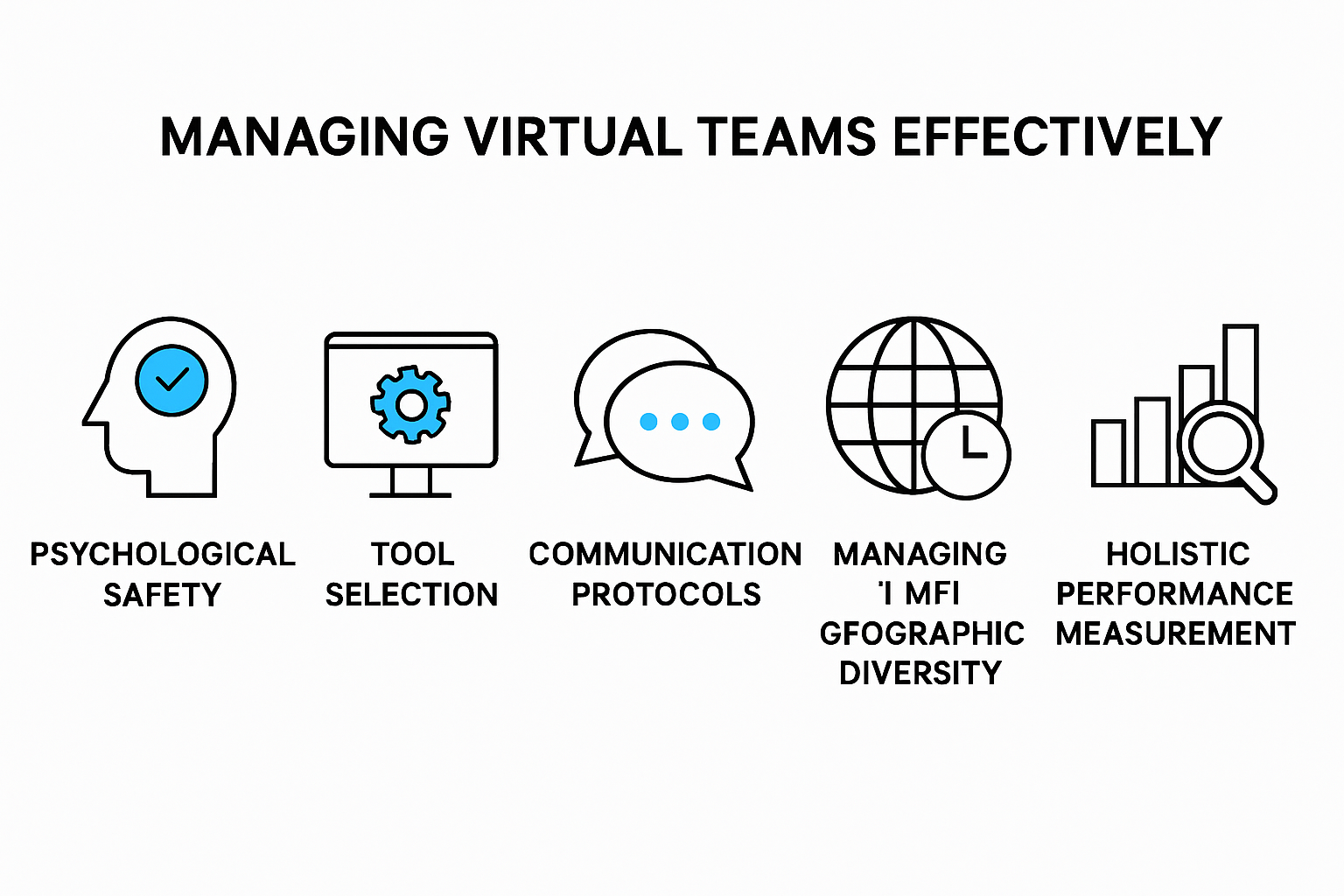Managing remote teams is no longer just a trend. By 2025 over 80 percent of organizations use virtual teams for core business functions, reshaping how leaders connect with their people. You might think more tech and tools would automatically solve the biggest hurdles. Actually the real breakthroughs in productivity come from human connection and smart management—not just the latest apps or platforms.
Table of Contents
- Building Trust And Communication Remotely
- Tools And Processes For Virtual Team Success
- Overcoming Challenges Unique To Virtual Teams
- Measuring Productivity And Performance In Remote Teams
Quick Summary
| Takeaway | Explanation |
|---|---|
| Creating Psychological Safety | Leaders must foster an environment where team members feel comfortable sharing ideas and concerns without fear of judgment. This includes transparent communication, active listening, and vulnerability from leaders. |
| Selecting the Right Tools | Choosing comprehensive collaboration platforms that integrate communication, project tracking, and document sharing is crucial for effective virtual team management. |
| Establishing Communication Protocols | Implementing structured communication practices, such as regular meetings and clear guidelines, ensures consistent engagement and helps reduce friction in virtual interactions. |
| Navigating Time and Geographic Diversity | Leaders should utilize shared calendars, flexible work hours, and asynchronous tools to manage teams across different time zones effectively. |
| Holistic Performance Measurement | Transitioning to outcome-based evaluation and utilizing technology-driven tracking tools allows for a more comprehensive assessment of team productivity and effectiveness. |

Building Trust and Communication Remotely
Managing virtual teams requires a strategic approach to building trust and maintaining robust communication channels. The geographic and technological barriers inherent in remote work demand intentional leadership techniques that bridge physical distances and create meaningful connections.
Creating Psychological Safety in Virtual Environments
Psychological safety emerges as a critical foundation for high-performing virtual teams. According to research by Kloepfer and Carbon, trust in virtual teams directly correlates with team performance, with leaders needing to demonstrate consistent responsibility and competence.
Successful virtual team leaders must create environments where team members feel comfortable sharing ideas, expressing concerns, and taking calculated risks without fear of ridicule or professional repercussions. This involves:
- Transparent Communication: Regular, clear updates about team goals and organizational changes
- Active Listening: Validating team members’ perspectives during virtual meetings
- Vulnerability: Leaders sharing their own challenges and learning experiences
Strategic Communication Practices
Research published in 2024 emphasizes that virtual leaders must proactively build high-trust environments. This requires moving beyond traditional communication models and embracing more nuanced, technology-enabled interaction strategies.
Effective communication in remote teams involves:
- Utilizing multiple communication platforms
- Establishing clear communication protocols
- Scheduling regular video check-ins
- Creating dedicated spaces for informal interactions
Maintaining Team Cohesion Through Digital Connections
A comprehensive study from 2021 highlights that e-leaders must cultivate trust through consistent communication and supportive behavior. This means going beyond transactional interactions and developing genuine human connections in digital spaces.
Key strategies include implementing virtual team-building activities, recognizing individual and collective achievements, and creating opportunities for spontaneous interactions that mimic the organic connections found in physical office environments. By prioritizing intentional communication and trust-building practices, leaders can transform potential remote work challenges into opportunities for enhanced collaboration and team performance.
Tools and Processes for Virtual Team Success
Successful virtual team management hinges on implementing robust tools and processes that facilitate seamless collaboration, communication, and productivity across distributed work environments. As remote work continues to evolve, leaders must strategically select and integrate technologies that bridge communication gaps and streamline team workflows.
Selecting Comprehensive Collaboration Platforms
The Project Management Institute emphasizes the critical importance of choosing collaboration platforms that support multiple aspects of team interaction. Effective tools should provide integrated solutions for:
- Communication Channels: Real-time messaging, video conferencing, and asynchronous communication options
- Project Tracking: Transparent task management and progress monitoring
- Document Sharing: Centralized repositories with version control and collaborative editing capabilities
- Integration Capabilities: Seamless connections with existing organizational software ecosystems
Leaders must evaluate platforms that offer comprehensive features while maintaining user-friendly interfaces that minimize learning curves and maximize team adoption.
To help readers compare the essential features needed in collaboration platforms, the following table summarizes their core components and benefits.
| Core Feature | Purpose/Benefit | Example Functions |
|---|---|---|
| Communication Channels | Facilitate real-time and asynchronous team interaction | Messaging, video meetings, chat, forums |
| Project Tracking | Monitor tasks, timelines, and deliverables | Kanban boards, Gantt charts, progress updates |
| Document Sharing | Centralize files and enable collaborative editing | File storage, version control, live editing |
| Integration Capabilities | Streamline workflows by connecting to other software | API connections, app integrations, automation |
Establishing Structured Communication Protocols
The Department of Homeland Security recommends implementing structured communication approaches to ensure consistent team engagement. Key strategies include:
- Creating weekly team meetings with structured check-in formats
- Developing clear guidelines for communication frequency and response expectations
- Implementing round-robin discussion techniques to ensure equal participation
- Establishing transparent status reporting mechanisms
These protocols help create predictability and reduce communication friction in virtual team environments, ensuring that all team members feel connected and informed.
Implementing Robust Process Management
Effective virtual team management requires more than just communication tools. Organizations must develop comprehensive process management strategies that address:
- Clear workflow documentation
- Standardized onboarding procedures for remote team members
By creating detailed process maps and utilizing adaptive project management methodologies, leaders can create flexible yet structured environments that support team productivity. This approach allows for both consistency and adaptability, crucial elements in managing distributed teams across different time zones and work contexts.
Ultimately, successful virtual team management is about creating a holistic ecosystem of tools, processes, and communication strategies that empower team members to collaborate effectively, regardless of physical location. Leaders who invest in comprehensive technological solutions and thoughtful process design will be best positioned to build high-performing virtual teams in the evolving work landscape.
Overcoming Challenges Unique to Virtual Teams

Virtual teams encounter distinct challenges that require strategic approaches and innovative solutions. Understanding and proactively addressing these challenges is crucial for maintaining team performance and organizational effectiveness.
Navigating Complex Communication Barriers
Research from organizational collaboration studies identifies communication as a primary challenge in virtual team environments. These barriers extend beyond traditional language differences and encompass technological, cultural, and interpersonal complexities.
Key communication challenges include:
- Misinterpretation of Digital Signals: Text-based communication lacks nuanced emotional context
- Technology Limitations: Inconsistent internet connectivity and platform compatibility
- Cultural Communication Styles: Variations in communication norms across different geographical regions
Leaders must develop comprehensive communication strategies that prioritize clarity, context, and cultural sensitivity. This involves implementing robust technology solutions and providing cross-cultural communication training.
Managing Time and Geographic Diversity
Technology and social practice research highlights the complexity of managing teams across multiple time zones. Successful virtual team management requires innovative approaches to scheduling, collaboration, and workflow coordination.
Strategies for addressing time and geographic challenges include:
- Utilizing shared digital calendars with multiple time zone displays
- Creating flexible working hours that accommodate global team members
- Implementing asynchronous communication tools
- Rotating meeting times to distribute inconvenience equitably
For a clearer overview, the following table outlines the main challenges unique to virtual teams alongside recommended strategies to address each challenge.
| Challenge | Description | Recommended Strategy |
|---|---|---|
| Misinterpretation of Digital Signals | Lack of emotional tone in text communication | Use video calls, clarify intent, feedback |
| Technology Limitations | Connectivity/platform issues | Provide tech support & reliable platforms |
| Cultural Communication Styles | Differences in norms across regions | Offer cross-cultural training |
| Time & Geographic Diversity | Multiple time zones, scheduling barriers | Use shared calendars & flexible hours |
| Weak Team Identity | Difficulty fostering cohesion without physical presence | Virtual team-building, shared activities |
Building Cohesive Team Identity
Leadership strategies from Wharton Executive Education emphasize the importance of developing a shared team identity despite physical separation. This involves creating opportunities for connection that transcend traditional workplace interactions.
Effective approaches include:
- Virtual team-building activities
- Regular informal communication channels
- Celebrating individual and collective achievements
- Creating shared digital spaces for non-work interactions
By recognizing and systematically addressing these unique challenges, leaders can transform potential obstacles into opportunities for innovation and team growth. The key lies in developing adaptive strategies that leverage technology, promote understanding, and create meaningful connections across digital environments.
Successful virtual team management requires continuous learning, flexibility, and a commitment to creating inclusive, supportive work environments that enable team members to thrive regardless of physical location.
Measuring Productivity and Performance in Remote Teams
Measuring productivity in remote teams requires a fundamental shift from traditional monitoring approaches to more holistic, outcome-focused performance evaluation strategies. Leaders must develop sophisticated methods that capture team effectiveness without relying on outdated, activity-based assessment techniques.
Redefining Performance Metrics
MIT Human Resources emphasizes the critical importance of evaluating work outcomes rather than tracking individual activities. This approach demands a more nuanced understanding of team performance that goes beyond simple time-tracking metrics.
Key considerations for modern performance measurement include:
- Outcome-Based Evaluation: Focus on deliverables and project completion
- Clear Goal Setting: Establishing measurable and specific objectives
- Qualitative Performance Indicators: Assessing collaboration, innovation, and problem-solving skills
- Regular Feedback Mechanisms: Implementing consistent communication channels
Successful performance measurement requires leaders to develop comprehensive frameworks that capture the complexity of remote work contributions.
Technology-Enabled Performance Tracking
The University of California, Santa Barbara recommends leveraging technology to create transparent and accountable performance management systems. Advanced tracking tools can provide insights that go beyond traditional monitoring approaches.
Effective technology-driven performance tracking involves:
- Implementing project management platforms with detailed progress tracking
- Using analytics to understand work patterns and productivity
- Creating dashboards that highlight team and individual achievements
- Developing automated reporting systems
These technological solutions enable leaders to gain comprehensive insights into team performance while respecting individual work styles and autonomy.
Holistic Performance Assessment Strategies
The National Academies Press highlights the need for adaptive performance measurement strategies that consider the unique dynamics of remote work environments. This approach requires a more comprehensive view of team productivity.
Holistic assessment strategies should include:
- 360-degree feedback mechanisms
- Periodic performance reviews that consider both quantitative and qualitative contributions
- Recognition of soft skills and collaborative abilities
- Continuous learning and development opportunities
By adopting a multifaceted approach to performance measurement, organizations can create more meaningful and motivating evaluation systems that support remote team success.
Ultimately, measuring productivity in remote teams is about creating a culture of trust, transparency, and continuous improvement. Leaders must move beyond traditional monitoring approaches and embrace more sophisticated, human-centered performance assessment strategies that recognize the full spectrum of team contributions.
Frequently Asked Questions
What are the key strategies for managing virtual teams effectively?
Key strategies include building trust and communication, selecting the right tools, establishing structured communication protocols, and addressing unique challenges related to time and geographic diversity.
How can leaders create psychological safety in virtual team environments?
Leaders can create psychological safety by fostering transparent communication, actively listening to team members, and demonstrating vulnerability through sharing their own challenges and learning experiences.
What tools are essential for successful virtual team collaboration?
Essential tools include comprehensive collaboration platforms that support communication, project tracking, and document sharing, as well as technologies that enable robust process management and engagement across distributed teams.
How should productivity and performance be measured in remote teams?
Productivity in remote teams should be measured through outcome-based evaluation, qualitative performance indicators, and technology-enabled tracking tools, focusing on deliverables and collaborative contributions rather than traditional activity-based metrics.
Elevate Your Virtual Team Leadership with Gammatica
Is your organization struggling to maintain trust, streamline communication, and track real outcomes in a remote environment? The article highlighted the reality that the right technology alone is not enough. True virtual team success comes from blending robust tools with human-centered strategies. This is where Gammatica.com transforms theory into action for business leaders.

If building psychological safety, syncing calendars, and measuring productivity are top of mind, our AI-driven platform offers exactly what you need. Automate repetitive tasks with pre-built templates, create shared checklists for remote teams, manage everything from project tracking to online meetings, and eliminate administrative headaches so you can focus on genuine leadership. Don’t let outdated processes hold your team back. Experience the ease and clarity of workflow management powered by Gammatica.
Visit Gammatica.com today to see for yourself how you can free up valuable hours weekly and empower your virtual teams in the new era of work.



